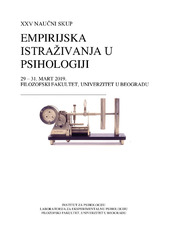Приказ основних података о документу
The effect of non-word length on types of errors in repetition of Serbian preschool children
| dc.creator | Popović, Maša | |
| dc.creator | Savić, Maja | |
| dc.creator | Batas, Ana | |
| dc.creator | Anđelković, Darinka | |
| dc.date.accessioned | 2023-08-09T08:28:43Z | |
| dc.date.available | 2023-08-09T08:28:43Z | |
| dc.date.issued | 2019 | |
| dc.identifier.isbn | 978-86-6427-091-5 | |
| dc.identifier.uri | http://reff.f.bg.ac.rs/handle/123456789/4660 | |
| dc.description.abstract | Typical phonological error patterns observed on the word, syllable, and phoneme level in children’s language production are sensitive to and vary across (supra)segmental contexts. A valid procedure for investigating the effect of different contexts on errors is the non-word repetition task with varied phonological structures. Continuing on our previous findings (Popović et al., 2017), which show a significant effect of non-word length on total repetition accuracy, the aim of this study was to examine this effect on specific types of errors in repetitions. The study included 75 monolingual typically developing (TD) Serbian children, aged 3 to 7. The used non-word repetition task consisted of 48 non-words constructed by systematically varying the number of syllables (two, three, and four), and three other phonological parameters: the position of syllable stress, onset and coda. The children’s task was to repeat each prerecorded non-word after hearing it. The repetitions were audio recorded, transcribed, and coded for 16 types of errors on the word, syllable and phoneme level. Two-way factorial ANOVAs, with factors age and number of syllables (N Syll.), were performed for the six most frequent errors in the repetitions. The following significant effects and interactions are shown for the different errors: Stress shifting: age (F(4, 70) = 8.124, p < .001), N Syll. (F(2, 140) = 118.5, p < .001), interaction (F(8, 140) = 2.576, p = .012); Onset consonant cluster reduction: age (F(4, 70) = 13.35, p < .001), N Syll. (F(2, 140) = 26.92, p < .001); Coda consonant omission: age (F(4, 70) = 8.645, p < .001), N Syll. (F(2, 140) = 15.84, p < .001); Coda consonant addition: age (F(4, 70) = 7.474, p < .001), N Syll. (F(2, 140) = 16.89, p < .001), interaction (F(8, 140) = 3.34, p = .002); Consonant metathesis: age (F(4, 70) = 11.01, p < .001), N Syll. (F(2, 140) = 86.05, p < .001), interaction F(8, 140) = 5.650, p < .001); Phoneme substitution: age (F(4, 70) = 30.97, p < .001), N Syll. (F(2, 140) = 130.5, p < .001), interaction (F(8, 140) = 2.41, p = .018). It may be concluded that with increasing non-word length, the repetition accuracy at all three levels (word, syllable, and phoneme) decreases in Serbian TD children, especially at younger ages. Three-year-olds have mastered some parameters of the shortest non-words, but make a large number of all errors on the longer ones. With age, children master word length, and at the age of 7 they make minimal errors, except for phoneme substitutions and stress shifting on the longest four-syllable non-words. | sr |
| dc.language.iso | en | sr |
| dc.publisher | Institut za psihologiju i Laboratorija za eksperimentalnu psihologiju, Filozofski fakultet, Univerzitet u Beogradu | sr |
| dc.relation | This study was designed as part of a multilingual parallel construction procedure of the LITMUS Cross-Linguistic Lexical Tasks within the networking program COST Action IS0804 Language Impairment in a Multilingual Society: Linguistic Patterns and the Road to Assessment^ (www.bi-sli.org; 2010-2013). | sr |
| dc.relation | European Coordination of Science and Technology COST Action A33: Cross-linguistically Robust Stages of Children's Linguistic Performance | sr |
| dc.relation | Ministry of Education, Science, and Technological Development, Republic of Serbia (project ON179033) | sr |
| dc.rights | openAccess | sr |
| dc.rights.uri | https://creativecommons.org/licenses/by/4.0/ | |
| dc.source | XXV naučni skup Empirijska istraživanja u psihologiji | sr |
| dc.subject | phonological development | sr |
| dc.subject | phonological error patterns | sr |
| dc.subject | non-word length | sr |
| dc.subject | Serbian | sr |
| dc.subject | preschool children | sr |
| dc.subject | fonološki razvoj | sr |
| dc.subject | obrasci fonoloških grešaka | sr |
| dc.subject | dužina pseudoreči | sr |
| dc.subject | srpski jezik | sr |
| dc.title | The effect of non-word length on types of errors in repetition of Serbian preschool children | sr |
| dc.type | conferenceObject | sr |
| dc.rights.license | BY | sr |
| dc.citation.epage | 42 | |
| dc.citation.spage | 42 | |
| dc.description.other | M34 | sr |
| dc.identifier.fulltext | http://reff.f.bg.ac.rs/bitstream/id/11538/bitstream_11538.pdf | |
| dc.identifier.rcub | https://hdl.handle.net/21.15107/rcub_reff_4660 | |
| dc.type.version | publishedVersion | sr |

